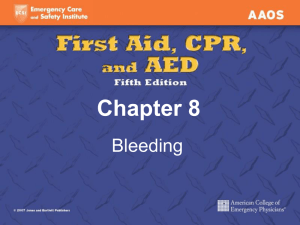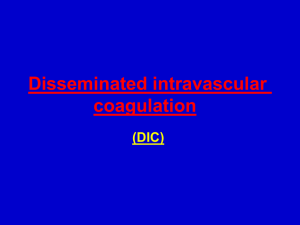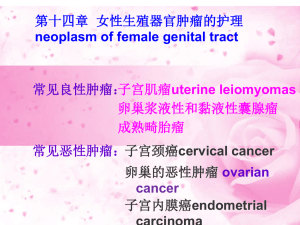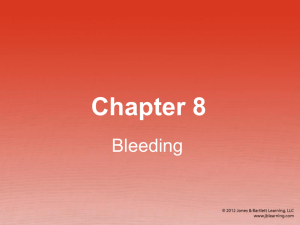Bleeding Time Test: Lab Procedure & Objectives
advertisement
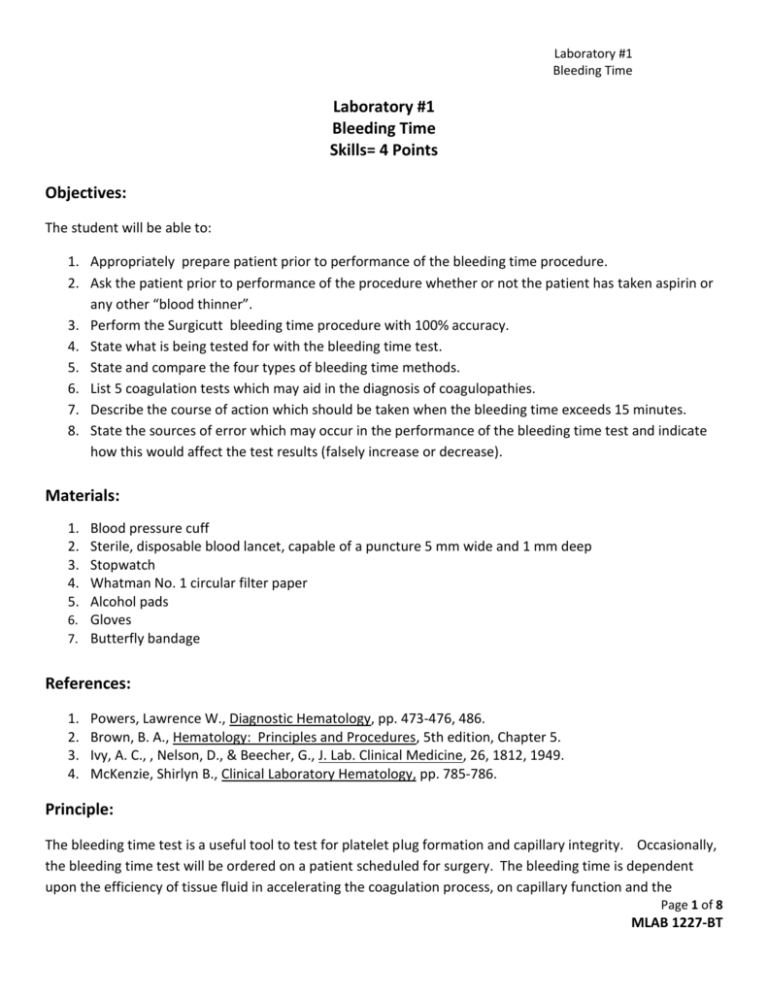
Laboratory #1 Bleeding Time Laboratory #1 Bleeding Time Skills= 4 Points Objectives: The student will be able to: 1. Appropriately prepare patient prior to performance of the bleeding time procedure. 2. Ask the patient prior to performance of the procedure whether or not the patient has taken aspirin or any other “blood thinner”. 3. Perform the Surgicutt bleeding time procedure with 100% accuracy. 4. State what is being tested for with the bleeding time test. 5. State and compare the four types of bleeding time methods. 6. List 5 coagulation tests which may aid in the diagnosis of coagulopathies. 7. Describe the course of action which should be taken when the bleeding time exceeds 15 minutes. 8. State the sources of error which may occur in the performance of the bleeding time test and indicate how this would affect the test results (falsely increase or decrease). Materials: 1. 2. 3. 4. 5. Blood pressure cuff Sterile, disposable blood lancet, capable of a puncture 5 mm wide and 1 mm deep Stopwatch Whatman No. 1 circular filter paper Alcohol pads 6. Gloves 7. Butterfly bandage References: 1. 2. 3. 4. Powers, Lawrence W., Diagnostic Hematology, pp. 473-476, 486. Brown, B. A., Hematology: Principles and Procedures, 5th edition, Chapter 5. Ivy, A. C., , Nelson, D., & Beecher, G., J. Lab. Clinical Medicine, 26, 1812, 1949. McKenzie, Shirlyn B., Clinical Laboratory Hematology, pp. 785-786. Principle: The bleeding time test is a useful tool to test for platelet plug formation and capillary integrity. Occasionally, the bleeding time test will be ordered on a patient scheduled for surgery. The bleeding time is dependent upon the efficiency of tissue fluid in accelerating the coagulation process, on capillary function and the Page 1 of 8 MLAB 1227-BT Laboratory #1 Bleeding Time number of blood platelets present and their ability to form a platelet plug. Prolonged bleeding times are generally found when the platelet count is below 50,000/µL, and when there is platelet dysfunction. When a patient is suspected of having a bleeding disorder, several tests are performed to screen defect(s) of primary hemostasis. These tests include the bleeding time, prothrombin time, activated partial thromboplastin time, platelet count, fibrinogen, and FDP. Coagulopathies or problems with hemostasis, such as thrombocytopenia, qualitative platelet defects, vascular abnormalities and von Willebrand’s disease can be diagnosed with coagulation tests. Four procedures are currently in use for determining the bleeding time: the Duke method, the Ivy Method, the Mielke Method and the Simplate or Surgicutt Method. Duke Method 1. A standardized puncture of the ear lobe is made, and the length of time required for bleeding to cease while the blood is being blotted every 30 seconds is recorded. 2. A lancet is used to make the puncture. 3. No repeat testing is allowed due to space. 4. Causes apprehension in the patient. 5. This test method is the easiest to perform, but is the least standardized and has the worst precision and accuracy. Ivy Method 1. A blood pressure cuff is used to maintain constant pressure within the capillaries to help standardize the procedure. The cuff is inflated to 40 mm Hg on the upper arm to control capillary tone and to improve the sensitivity and reproducibility. 2. The forearm is the bleeding time site used. 3. A sterile, disposable blood lancet is used and the length of time required for bleeding to cease is recorded. 4. The greatest source of variation in this test is largely due to difficulty in performing a standardized puncture. This usually leads to erroneously low results. Mielke Method 1. Modification of the Ivy Method. 2. A Bard-Parker or similar disposable blade is used, along with a rectangular polystyrene or plastic template that contains a standardized slit. The blade is placed in a special handle containing a gauge in order to standardize the depth of the incision. 3. The same procedure as described for the Surgicutt method is employed. 4. Advantages of this method include: Page 2 of 8 MLAB 1227-BT Laboratory #1 Bleeding Time a. That the surgical incision more closely approximates the patient’s hemostatic response to surgery, when compared to the puncture in the Ivy Method. b. The depth of the incision can be controlled. 5. Disadvantages of this method include: a. Cost- scalpel and template required sterilization after each use. b. Patient apprehension, due to unconcealed scalpel. c. Small scars might form. Simplate/Surgicutt Method: Preferred Method 1. Modification of the Ivy Method. 2. The first bleeding time device introduced was the Simplate. The Simplate device has a trigger and spring method for the blade. The blade has a depth of 1.0 mm and a width of 5.0 mm. Another brand name is the Surgicutt. 3. Advantages of this method include: a. Instrument is a sterile, standardized, easy to use device that makes a uniform incision. b. Instrument is a spring activated surgical steel blade which is housed in a plastic unit. This eliminates variability of blade incision. c. This method is the most standardized method of all the bleeding time procedures. d. Inexpensive 4. Disadvantages of this method include: a. Slight scarring can occur so patient should be informed. Preparation of the Patient After proper greeting and identification of the patient, explain that a "bleeding time" has been ordered by his/her doctor. This test is used to see how long it will take for the patient to stop bleeding and a clot to form after a puncture is made in the forearm. Unless the patient is an infant, outline to the patient how the test will be done. Explain that the test will take approximately 10 to 20 minutes to complete. Let the patient know that he may experience some discomfort from the incision and the cuff of the sphygmomanometer. After explaining the procedure to the patient, stop and ask if they have any additional questions. The technician may respond to any questions the patient has concerning the procedure ONLY. If the patient inquires about the significance of the test relative to his/her condition, he/she should be referred to the physician who ordered the test. The patient's physician can interpret test results within the context of each patient's condition. It is critical that you ask the patient whether or not they have taken aspirin, aspirin containing compounds (many over the counter medications contain aspirin) or blood thinners such as heparin or coumadin recently. These drugs will cause a falsely abnormal bleeding time and the test should not be done. Page 3 of 8 MLAB 1227-BT Laboratory #1 Bleeding Time Overview of Procedure Select a site on the patient’s forearm approximately three fingers widths below the bend in the elbow that is free of visible subcutaneous veins. Avoid surface veins, scars, bruises and edematous areas. Apply the blood pressure cuff and inflate to 40 mm Hg. Perform the incision after the cuff has been in place 30-60 seconds. Apply the bleeding time device to the arm in a horizontal position, do NOT apply undue pressure as this will falsely increase the depth of the incision. Start the stop watch as soon as the incision is made. The blood is wicked onto the filter paper at 30 second intervals taking great care that the wound is NOT directly touched with the filter paper. Once blood no longer stains the filter paper the timing is stopped. The bleeding time is reported out to the nearest 30 seconds. Procedure: 1. Greet and identify the patient. 2. Explain the procedure to the patient. 3. Obtain a history about aspirin or aspirin containing compounds taken within last 7 - 10 days. 4. Select a site on the patient's forearm approximately three fingers widths below the bend in the elbow that is free of visible subcutaneous veins. 5. Cleanse the outer surface of the patient's forearm by moving the alcohol pad in concentric circles from the incision site outward; allow to air dry. 6. Place a blood pressure cuff on the patient's arm above the elbow. Turn the knob on the bulb of the sphygmomanometer until it stops. Squeeze the bulb to inflate the sphygmomanometer. Inflate the cuff and maintain pressure at 40 mm Hg. 7. Remove the Surgicutt device from the blister pack, being careful not to contaminate or touch the blade-slot surface. Remove the safety clip. 8. Depress the “trigger” on the bleeding time device. The puncture must be performed within 30 to 60 seconds of inflation of the blood pressure cuff. Simultaneously start the stopwatch. 9. After 30 seconds have passed blot (do not wipe) the blood with the filter paper. The filter paper must not touch the wound on the arm. Blot the site at regular thirty second intervals. Rotate the filter paper after each 30 seconds. 10. When bleeding ceases and blood no longer is drawn to the filter paper, stop the watch and release the blood pressure cuff by turning the knob next to the bulb in the opposite direction used to inflate the cuff. Remove the blood pressure cuff. 11. Record the bleeding time. Bleeding time is determined to the nearest 30 seconds. 12. If bleeding continues for more than 15 minutes, the procedure should be discontinued, and pressure applied to the wound sites. The bleeding time should be repeated on the other arm. If bleeding has again not ceased within 15 minutes, the results are reported as greater than 15 minutes. 13. After ensuring that the bleeding has stopped, carefully bandage the site. 14. Appropriately discard all used materials and wash hands. Page 4 of 8 MLAB 1227-BT Laboratory #1 Bleeding Time Normal Values 1.0 – 9.0 minutes Quality Control Quality control is accomplished through the standardization of the procedure. The wound should be a standard length and depth and a constant pressure of 40 mmHg should be maintained throughout the procedure. Sources of Error/Troubleshooting 1. 2. 3. 4. 5. 9. If the patient has taken aspirin or aspirin-containing compounds 7 to 10 days prior to the procedure, the bleeding time may be prolonged. The technician must determine the patient's history concerning aspirin ingestion to ensure quality results. Aspirin blocks the formation of thromboxane and prostacyclin in both platelets and endothelial cells. This results in abnormal aggregation of the platelets. Damage from aspirin effects the platelets for its entire life span. Results may be affected by an improperly performed puncture. A puncture that is too shallow, too deep, or in an inappropriate location will adversely affect test results. The alcohol must be completely dried before making the puncture. If residual alcohol is on a puncture site, the bleeding time will be erroneously prolonged. If the technician does not initiate timing of the procedure simultaneously with the puncture, the results will be adversely affected. If the technician allows the filter paper to touch the wound, the platelet clot may be dislodged, causing falsely elevated results. If the stopwatch has not been appropriately calibrated, it may keep incorrect time. Stopwatches should be calibrated on a regular basis as a part of the quality assurance program. 10. The direction of the incision should be consistent. A horizontal incision gives a longer bleeding time than a vertical incision. 11. The bleeding time is prolonged in thrombocytopenia, hereditary and acquired platelet dysfunctions, von Willebrand's disease, afibrinogenemia, severe hypofibrinogenemia, and some vascular bleeding disorders. 12. Certain drugs like Plavix and Ticlid, which are platelet inhibitors can falsely prolong the bleeding time. NOTE: If bleeding continues for more than 15 minutes, the procedure should be discontinued, and pressure applied to the wound sites. The bleeding time should be repeated on the other arm. If bleeding has again not ceased within 15 minutes, the results are reported as greater than 15 minutes. Page 5 of 8 MLAB 1227-BT Laboratory #1 Bleeding Time Name________________________ Date_________________________ Laboratory # 1: Template Bleeding Time Report Skills=4 points Must include appropriate units. Patient Name Patient ID Result Within Reference Range? Page 6 of 8 MLAB 1227-BT Laboratory #1 Bleeding Time Name____________________ Date_____________________ Laboratory #1 : Bleeding Time Study Questions Points= 15.5 1. What is the bleeding time useful for? (1 pt) 2. A. List four (4) types of bleeding times that can be performed. (2 pts) B. Which is the easiest to perform but gives the least accurate results? (0.5 pts) C. Which is the method of choice? (0.5 pts) 3. What other coagulation tests are used in conjunction with the bleeding time to diagnose bleeding disorders? (2.5 pts) 4. List two conditions in which the bleeding time could be prolonged. (1 pt) Page 7 of 8 MLAB 1227-BT Laboratory #1 Bleeding Time 5. A. Why is a blood pressure cuff used in the Ivy bleeding time? (1 pt) B. What pressure should the cuff be kept at? (1 pt) C. How often should the puncture site be blotted? (1 pt) 6. What is the normal range for Ivy bleeding times? (1 pt) 7. State the course of action which should be taken when the bleeding time exceeds 15 minutes. (1 pt) 8. List three sources of error in the bleeding time procedure. (3 pts) Page 8 of 8 MLAB 1227-BT



